明治大学・各研究科横断型カリキュラム・プロジェクト系科目・先端数理科学I「芸術の中の数理」
明治大学秋葉原キャンパス
2008年9月10日(水)
錯視・数学・美
北岡 明佳(Akiyoshi Kitaoka)
(立命館大学 文学部 心理学専攻) email
since September 8, 2008
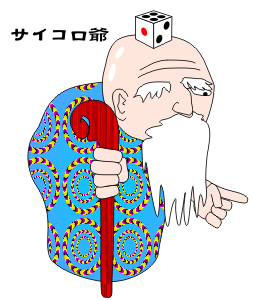 錯視とは?
錯視とは? 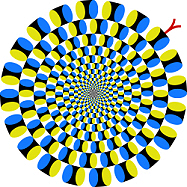
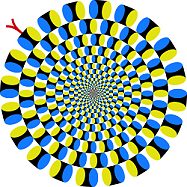
●錯視を研究しているのは、おもに心理学(psychology)である。
●錯視(visual illusion)とは視覚性の錯覚のことであり、錯覚とは実在する対象の真の特性とは異なる知覚のことである。
●錯視には、形の錯視(幾何学的錯視)、明るさの錯視、色の錯視、運動視の錯視などがある。だまし絵なども錯視に含められることがある。
●特に生存の役には立たないと思われる現象ほど錯視と呼ばれやすい。
●わかりやすい現象ほど錯視と呼ばれやすい。
●錯視は、錯視量が多いほど「美しい」(Noguchi and Rentschler, 1999)。しかし、その科学的根拠は不明である。
錯視のカタログ(ウェブページ) 北岡の錯視本(ウェブページ)
立命館大学の桜(平成19年4月8日)

「入学式」
灰色で描いたサクラの花びらに、色が付いて見える。
Copyright Akiyoshi .Kitaoka 2007 (March 2)
図にカーソルを載せると、花びらは灰色であることがわかる。
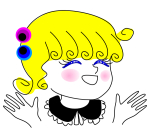 静止画が動いて見える錯視
静止画が動いて見える錯視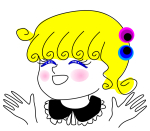
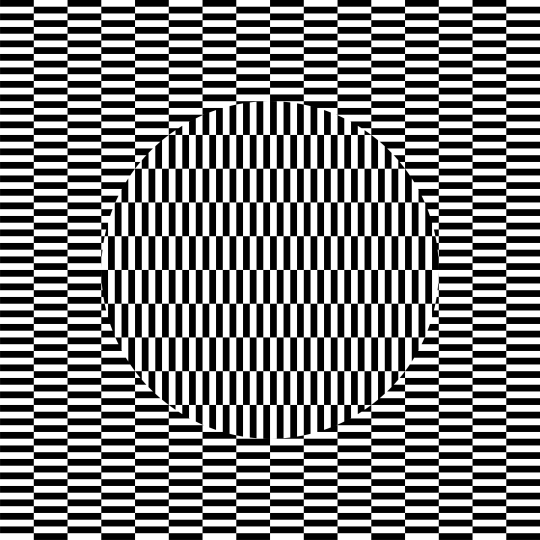
オオウチ錯視(蘆田最適化版)
内側の領域が動いて見える。
References
Ouchi, H. (1977) Japanese optical and geometrical art.
Mineola, NY: Dover.
Spillmann, L., Heitger, F. and Schuller, S. (1986)
Apparent displacement and phase unlocking in checkerboard patterns. Paper
presented at the 9th European Conference on Visual Perception, Bad
Nauheim
Ashida, H. (2002) Spatial frequency tuning of the Ouchi
illusion and its dependence on stimulus size. Vision Research, 42,
1413-1420.
「踊るハート達」
ハートが動いて見える。めがねをかけている人は、めがねを動かすとよく見えるかもしれない。離れたところから見ると、明るくなった時のハートは白のランダムドットより手前に見え、暗くなった時のハートは奥に見える人が過半数と予想される。
Copyright Akiyoshi Kitaoka 2006 (December 20)
文献
Kitaoka, A. and Ashida, H. (2007) A variant of
the anomalous motion illusion based upon contrast and visual latency.
Perception, 36, 1019-1035. ![]() PDF
PDF
Kitaoka, A, Kuriki, I. and Ashida, H. (2006) The center-of-gravity model of chromostereopsis. Ritsumeikan Journal of Human Sciences, 11, 59-64. PDF
モノクロでOK

配布物
「踊るハート達」 (MS-Word ファイル)
北岡明佳 (2006) 色が強くなる錯視 A・F・Tジャーナル, 31 (Summer), pp. 01.
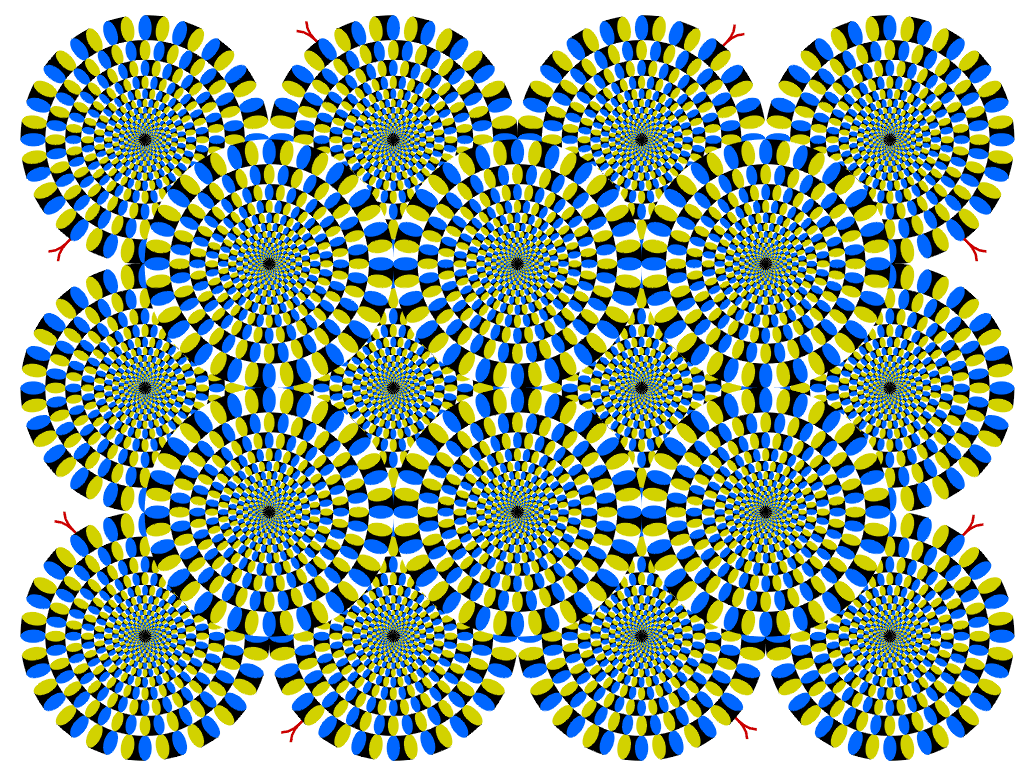
「蛇の回転」
蛇の円盤が勝手に回転して見える。
Copyright A.Kitaoka 2003 (September 2, 2003)
(配布物)
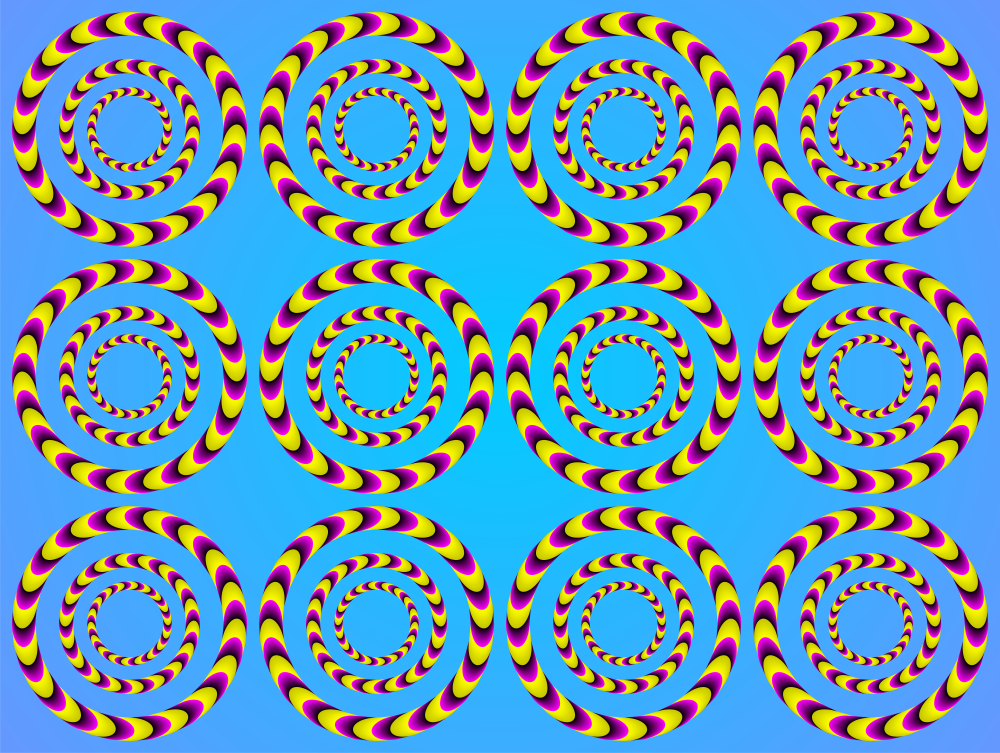
「赤い蛇の回転の詰め合わせ」
リングがゆっくり、あるいは急速に回転して見える。
Copyright Akiyoshi Kitaoka 2008 (March 19)
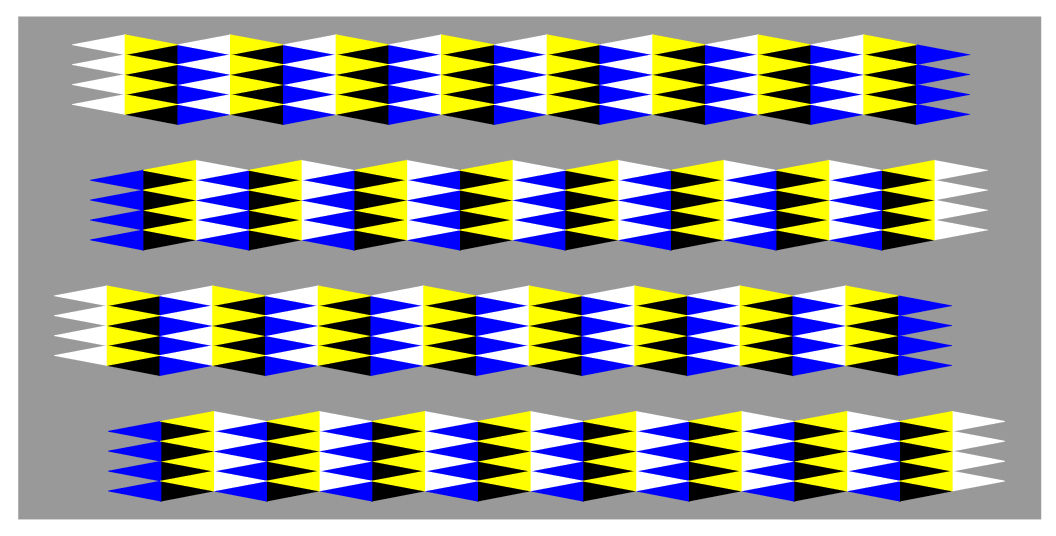
「ジグザグ虫」
上から一番目と三番目のブロックは右に、二番目と四番目は左に動いて見える。
Copyright Akiyoshi Kitaoka 2007 (April 16)
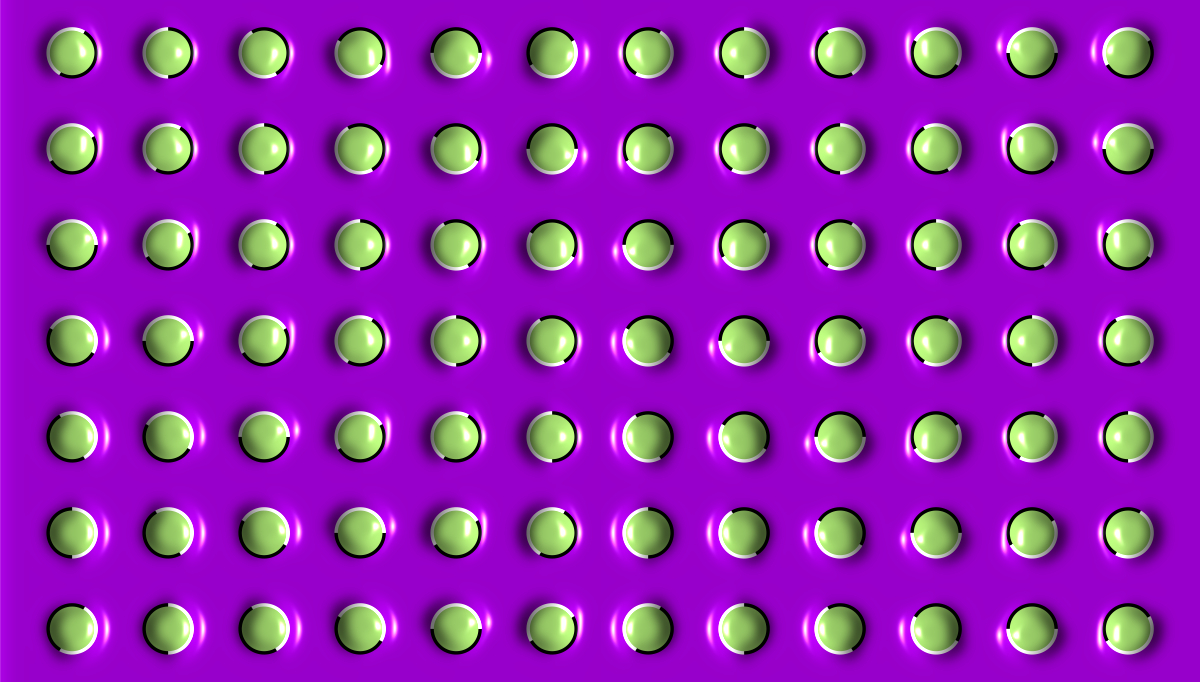
「えんどう豆の仕分け」
左半分は左に、右半分は右に動いて見える。
Copyright Akiyoshi Kitaoka 2008 (August 16)
(北岡による勝手な)
最適化型フレーザーウィルコックス錯視の最新の分類
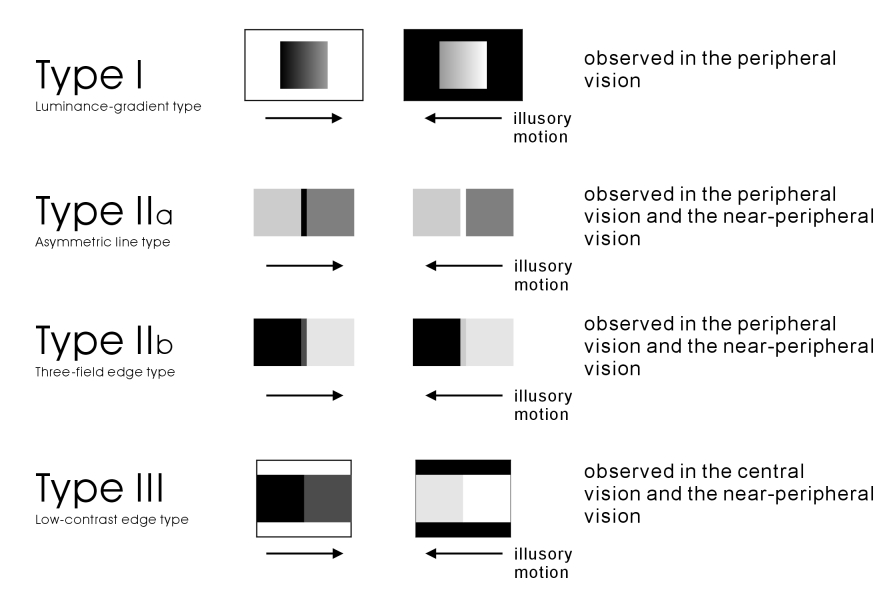
Optimized Fraser-Wilcox illusion の基本図形
Type I (six) 1500 x 1000
Type IIa (six) 1500 x 1007
Type IIb (six) 1500 x 1000
Type III 1500 x 400
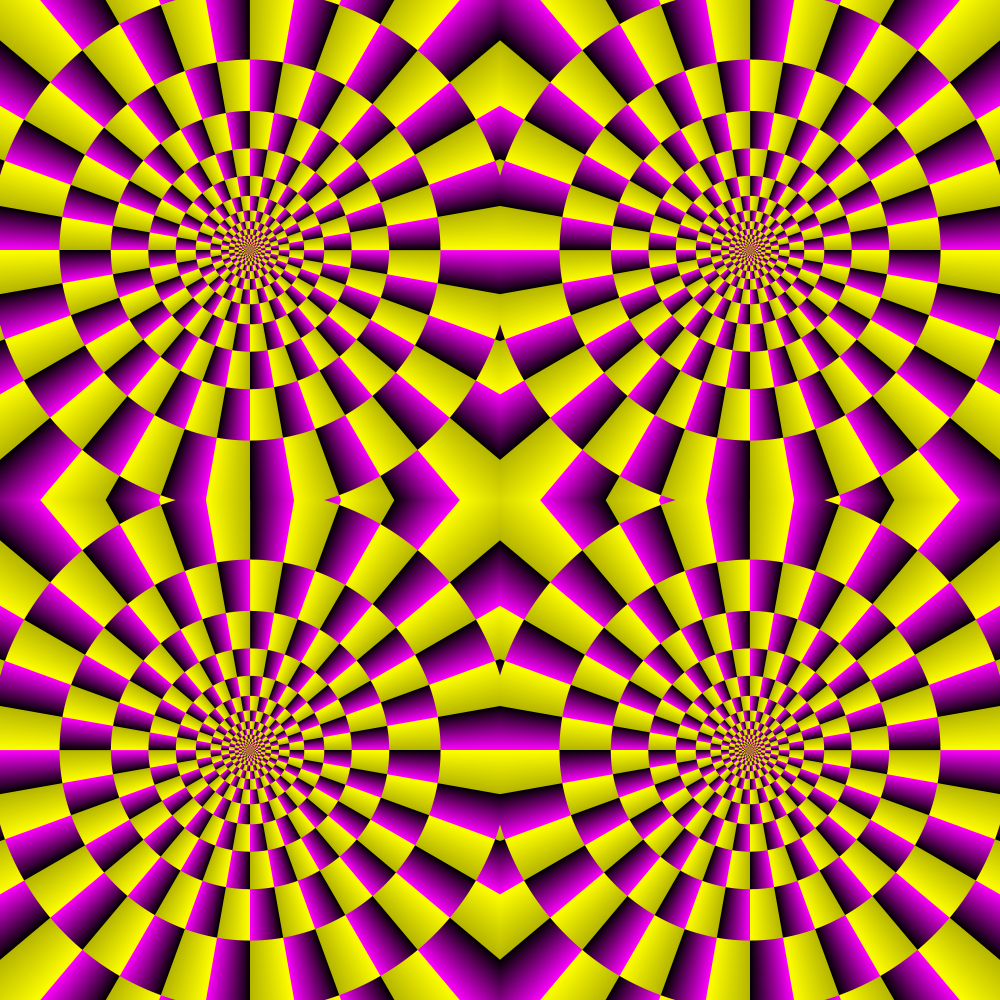
"The time tunnel show"
Rings appear to rotate.
Copyright Akiyoshi.Kitaoka 2006 (February24)
Effects of color on the "optimized Fraser-Wilcox" illusion
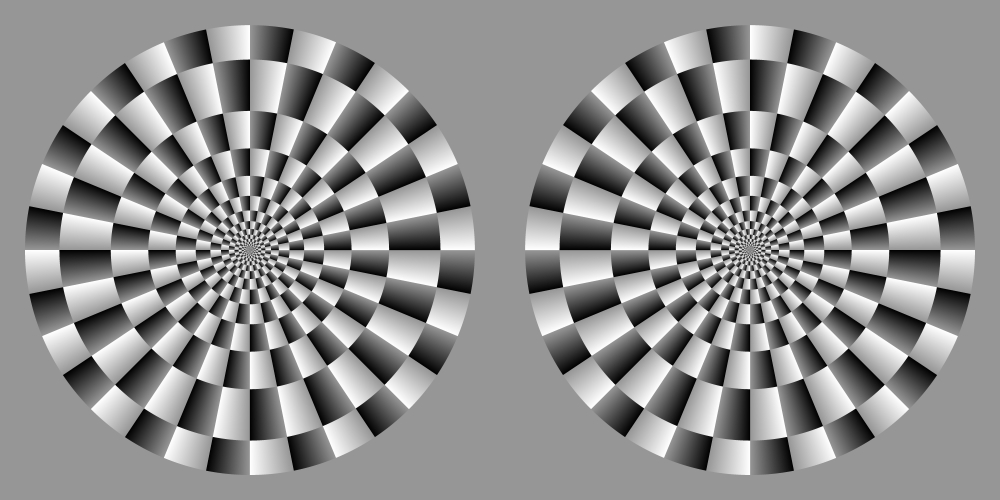
Black » Gray; White » Gray
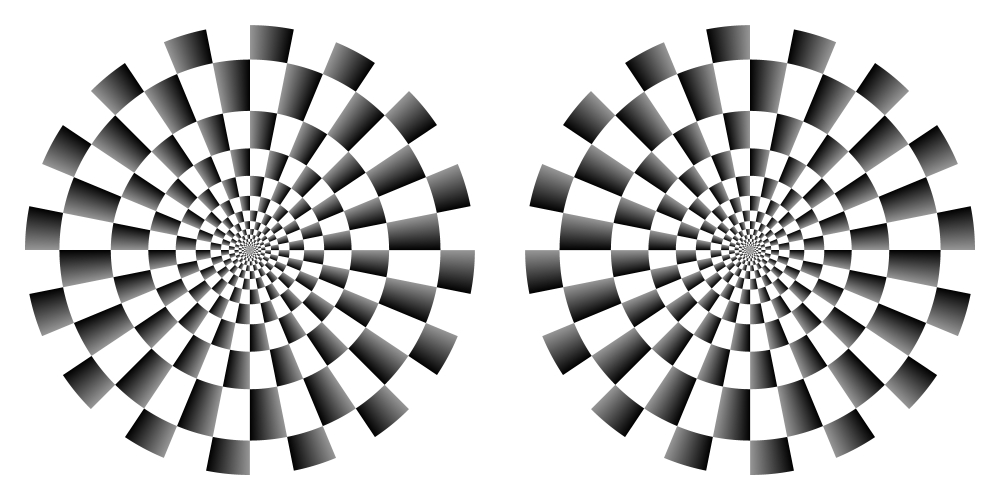
Black » Gray
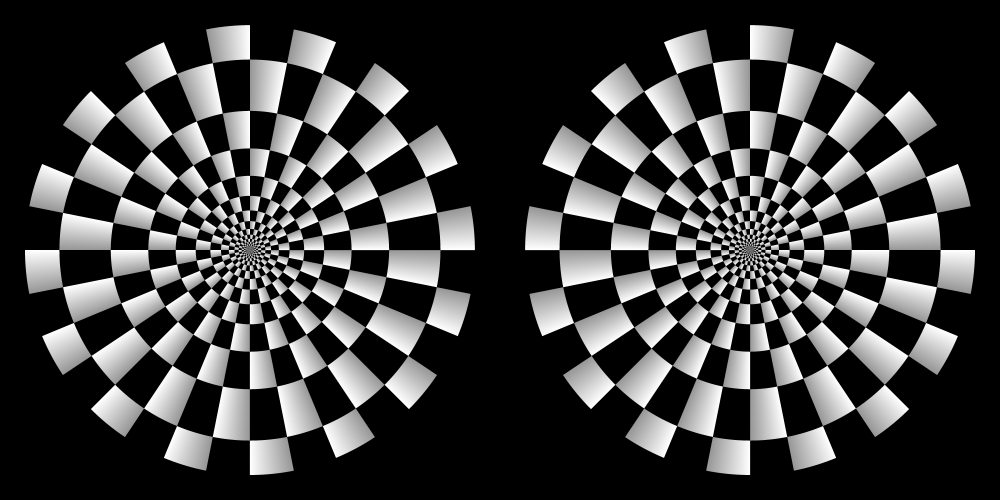
White » Gray
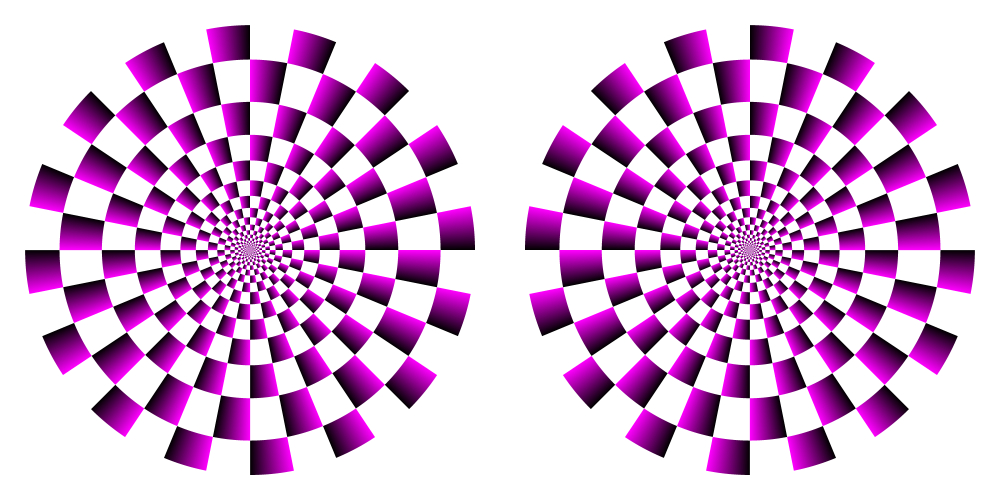
Black » Gray is replaced with Black » Magenta
Observation 1 The illusion from dark to light is enhanced by red or blue.
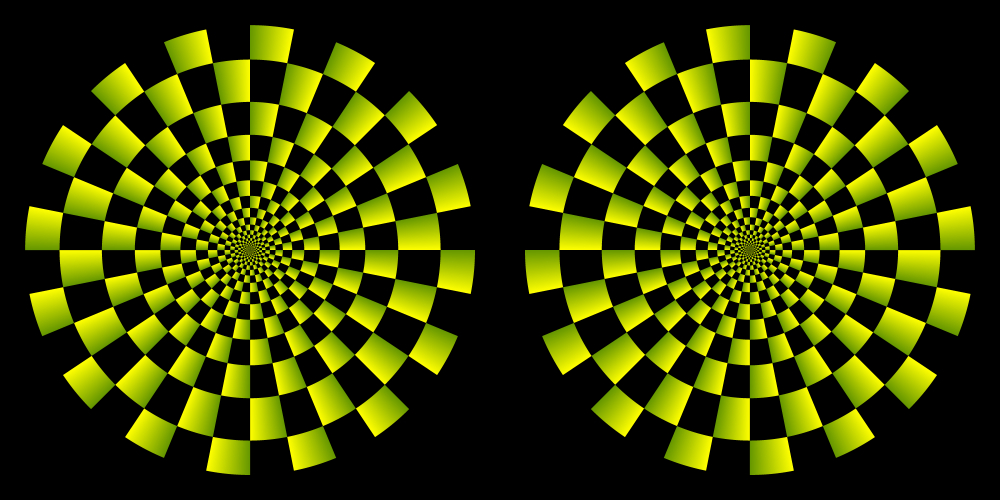
White » Gray is replaced with Yellow » Green
Observation 2 The illusion from light to dark is enhanced by yellow or green.
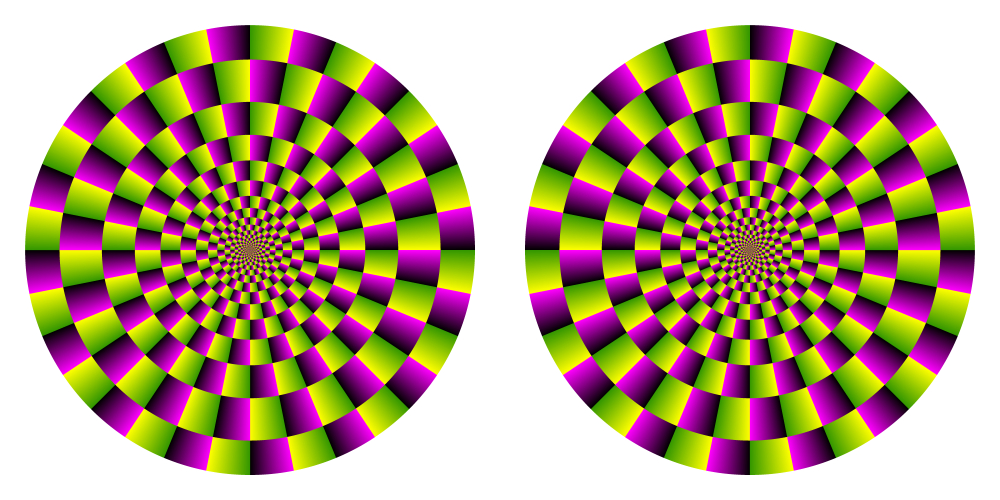
Black » Gray is replaced with Black » Magenta
White » Gray is replaced with Yellow » Green
Observation 3 The illusion from dark to light is enhanced by red or blue, and the illusion from light to dark is enhanced by yellow or green. Both illusions work additively.
参考書
北岡明佳著 人はなぜ錯視にだまされるのか? トリック・アイズ メカニズム カンゼン (2008年7月刊行) ![]() new!
new!
北岡明佳(監修) ニュートン別冊 脳はなぜだまされるのか? 錯視
完全図解 (2007年10月刊行) ![]()
北岡明佳著 だまされる視覚 錯視の楽しみ方 化学同人 (2007年1月刊行) 好評発売中 ![]()
作図の実習 (しないけど)
塗りつぶし属性と線属性
グラデーションと ブレンド
ワードで作ってみよう →そのワードファイル
北岡明佳 (2005) 目の冒険・錯視の話⑤ 自分で作って「傾く」「動く」 朝日新聞, 2005年7月31日発行 be on Sunday, p7. (配布プリント、実習用)
ワードで作ってみよう →そのワードファイル
ベジェ曲線説明ファイル

「蛇の回転」
蛇の円盤が勝手に回転して見える。
Copyright A.Kitaoka 2003 (September 2, 2003)
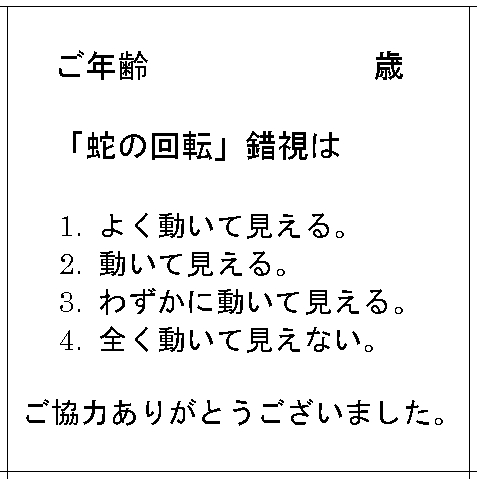
質問紙(調査票)
 渦巻き錯視
渦巻き錯視 
同心円(中心が同じ複数の円)が渦巻きに見える現象
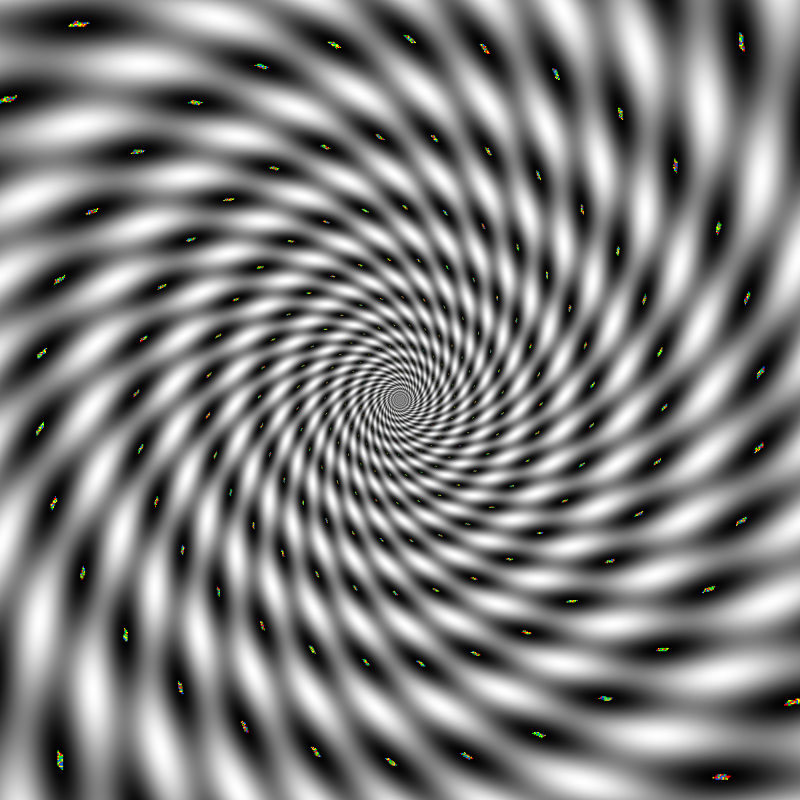
"Spiral warp"
Concentric rings appear to be spirals.
Copyright Akiyoshi Kitaoka 2007 (June 29)
equiangle = 45 deg
The spiral illusion of the Zöllner illusion:
Kitaoka, A., Pinna, B., and Brelstaff, G. (2001). New variations of spiral illusions. Perception, 30, 637-646.
"Spiral blood vessel"
Red concentric rings appear to be spirals.
Copyright Akiyoshi Kitaoka 2007 (June 26)
The spiral illusion of the Fraser illusion (Fraser spiral):
Fraser, J. (1908) A new visual illusion of direction. British Journal of Psychology, 2, 307-320.
The Fraser illusion of this type:
Skillen, J., Whitaker, D., Popple, A., and McGraw, P. V. (2002) The importance of spatial scale in determining illusions of orientation. Vision Research, 42, 2447-2455.
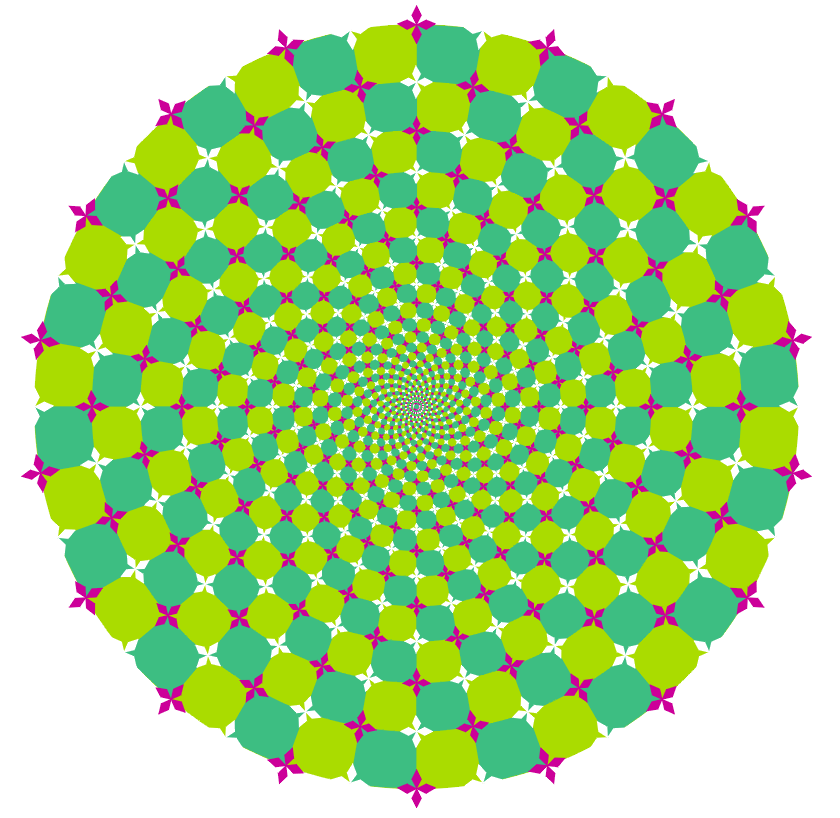
"Primrose's spirals"
Concentric arrays of "flowers" appear to be spirals.
Copyright A.Kitaoka 2002
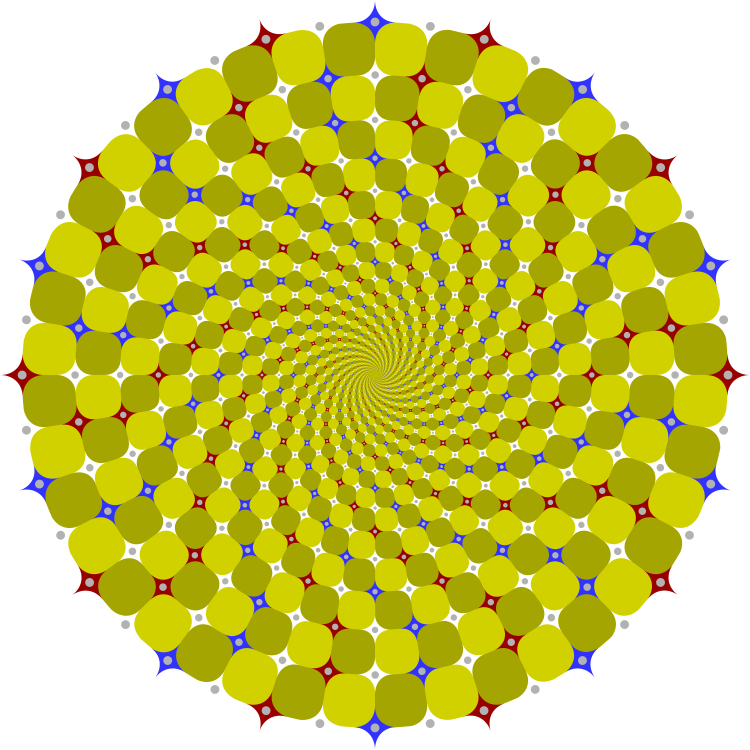
"Neural circuit spirals 2"
Concentric circles appear to be spirals (going to the center by rotating clockwise). Moreover, the inner part appears to rotate clockwise (counterclockwise) when observers approach (move away from) the image keeping their eyes fixed at the center.
Copyright Akiyoshi Kitaoka 2007 (August 7)
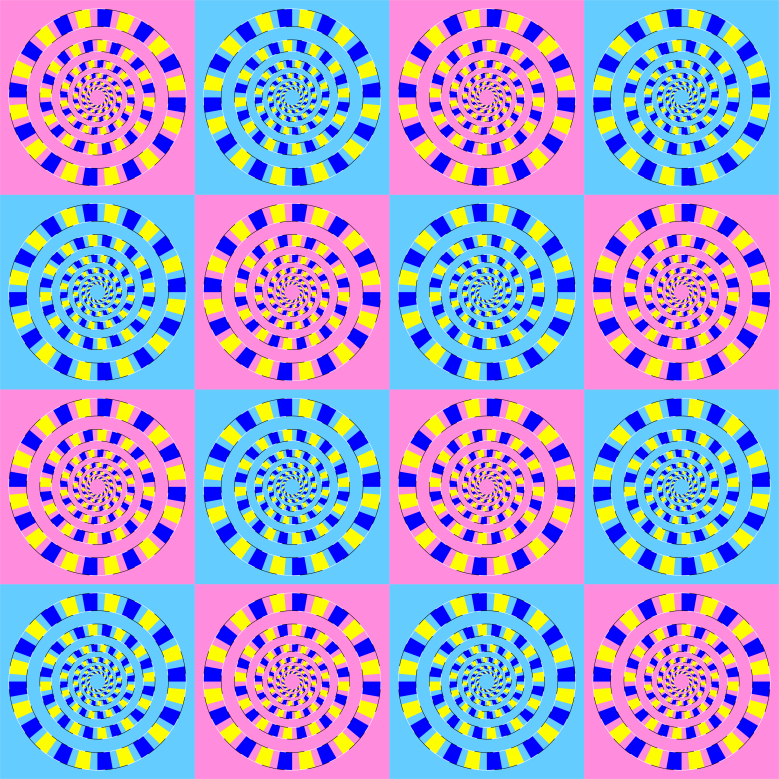
"Packed spirals"
Concentric rings appear to be spirals. Moreover, each set of rings appears to rotate.
Copyright Akiyoshi Kitaoka 2006 (June 13)
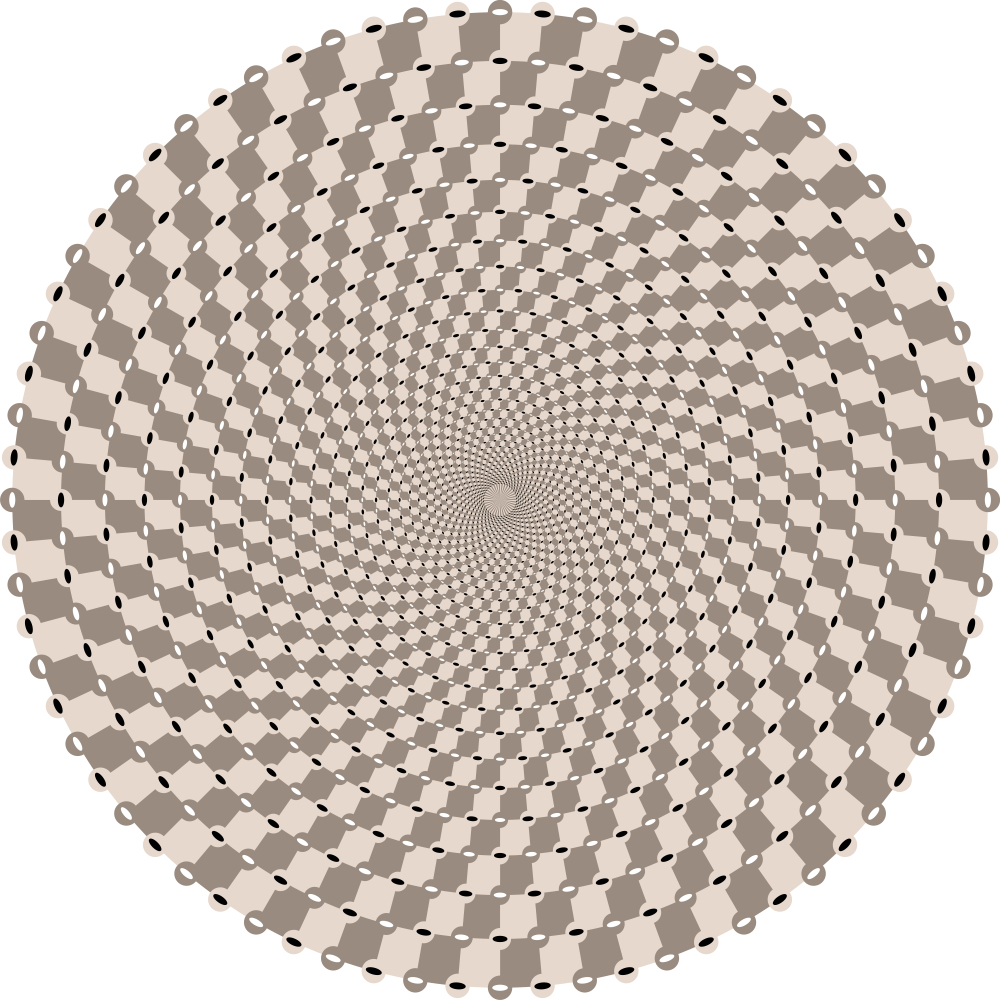
"Songs of
frogs"
(a remake)
Concentric arrays of dots appear to be spirals.
Copyright Akiyoshi Kitaoka 2008 (January 2008)
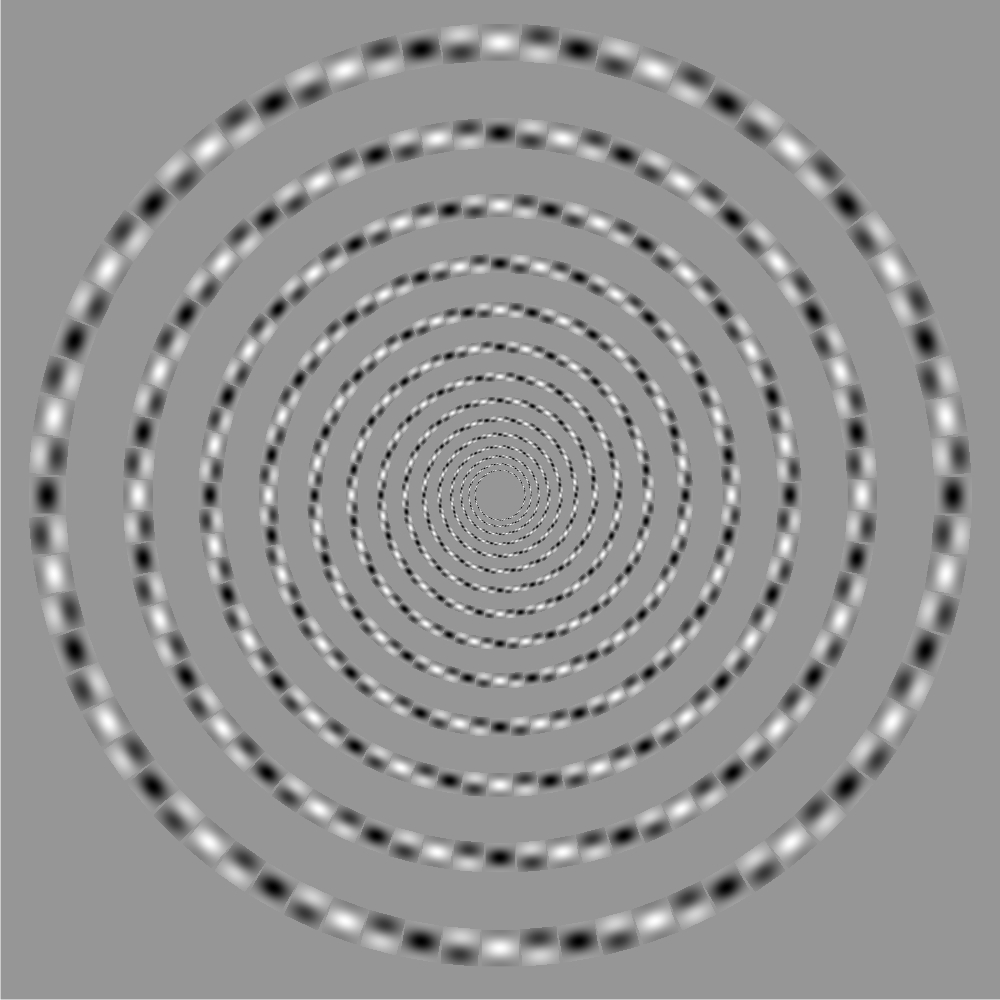
"Cyanophyceae spiral"
Concentric circles appear to be a spiral.
Copyright Akiyoshi Kitaoka 2007 (August 29)
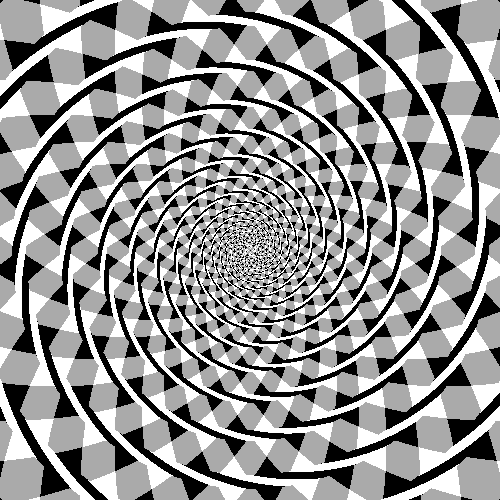
First presented by Fraser (1908); Reproduced by Akiyoshi Kitaoka (2003)
Fraser's spiral
The term "spiral illusion" had long referred to the spiral illusion of the Fraser illusion (Fraser, 1908) before we elucidated that any tilt illusion can form spiral illusion (Kitaoka, Pinna and Brelstaff, 2001). This page shows a copy of Fraser's spiral produced by PC programming. <2003/8/30>
Fraser, J. (1908) A new visual illusion of direction. British Journal of Psychology, 2, 307-320.
Kitaoka, A., Pinna, B., and Brelstaff, G. (2001). New variations of spiral illusions. Perception, 30, 637-646. PDF
Catalogue of spiral illusions (in Japanese) (配布物)
北岡明佳 (2006) 渦巻き錯視のメカニズム じっきょう数学資料, 52, 13-15. PDF (配布物)
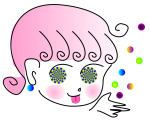 Suggested function
Suggested function
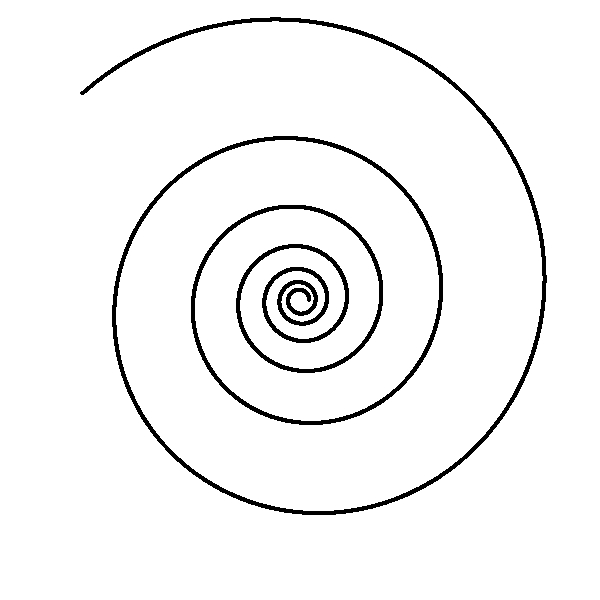
Bernoulli's spiral
r = a exp (k θ)
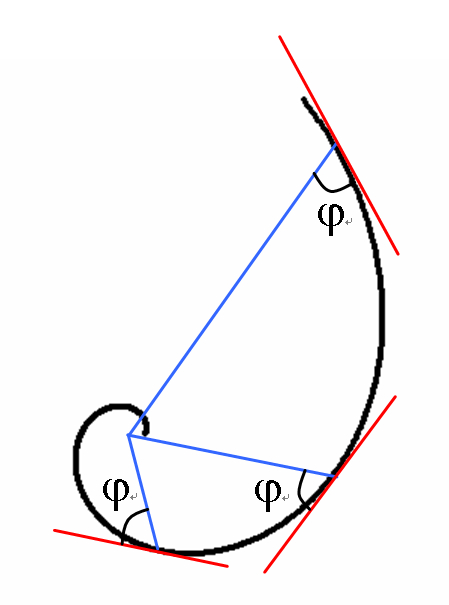
= equiangular spiral
k = 1 / tan (φ)
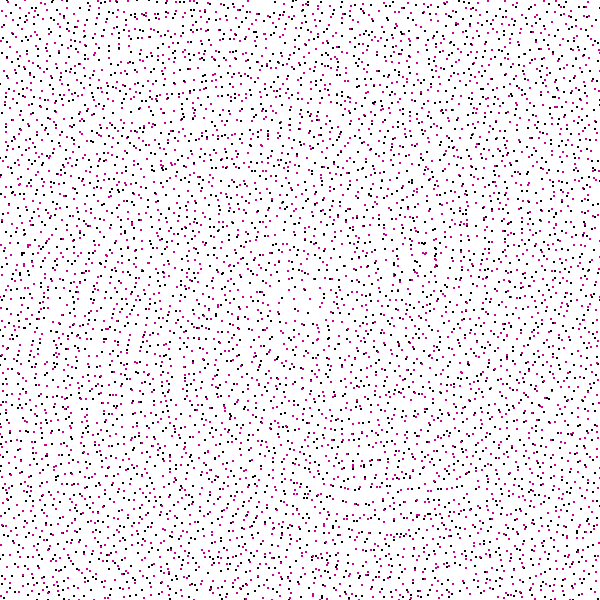
Spiral Glass pattern
φ = 70º
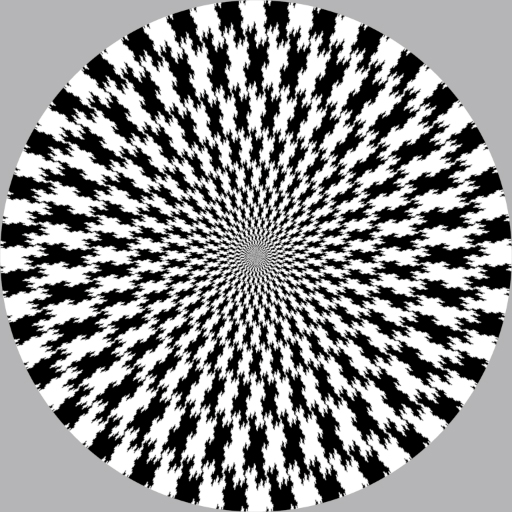
"Fractal spiral illusion"
Concentric rings made up of fractal islands appear to form spirals.
Copyright Hitoshi & Shinobu Arai
2007
from Professor Hitoshi Arai,
Graduate School of Mathematical Sciences, University of Tokyo, October 4,
2007
北岡明佳のコメント: 原理としてはフレーザー錯視のようですが、それよりもなによりも、世界初のフラクタル錯視図形 なのではないでしょうか!? 新井先生の視覚数学e研究室報告に、この錯視の論文が出ました。 <2007年10月4日>
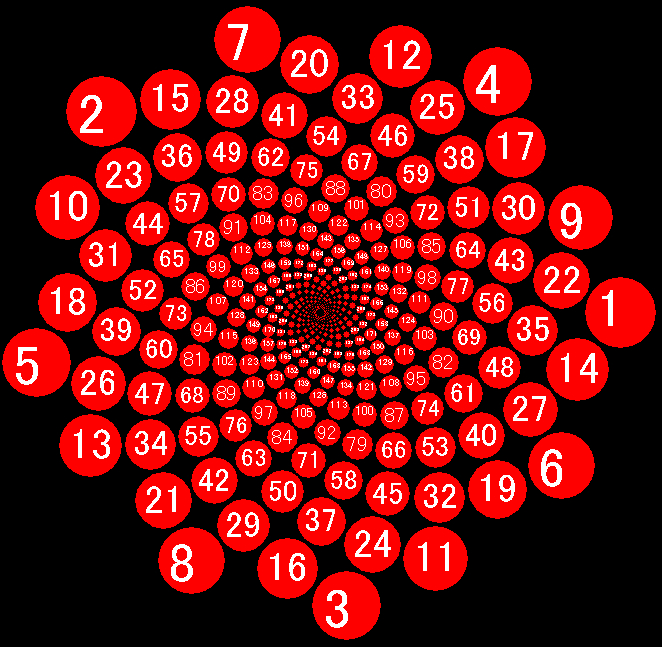
黄金角の螺旋の図(配布プリント)
フィボナッチ数列 1 1 2 3 5 8 13 21 34 55 89 144 ・・・
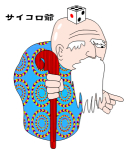 近接の法則
近接の法則
参考書
| 渡邉泰治 | 黄金比の謎 美の法則を求めて  |
化学同人 | 2007 |
 線遠近法は錯視なのか?
線遠近法は錯視なのか? 
網膜座標系と錯視
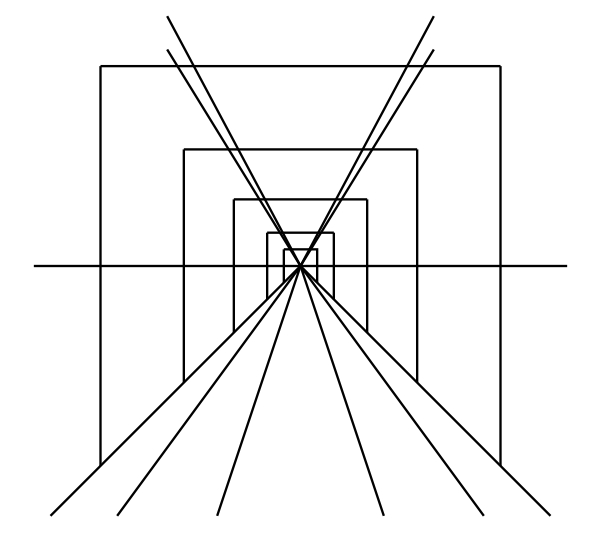
文献 Kitaoka, A. (2007) Psychological approaches to art. Japanese Journal of Psychonomic Science,26, 97-102. PDF
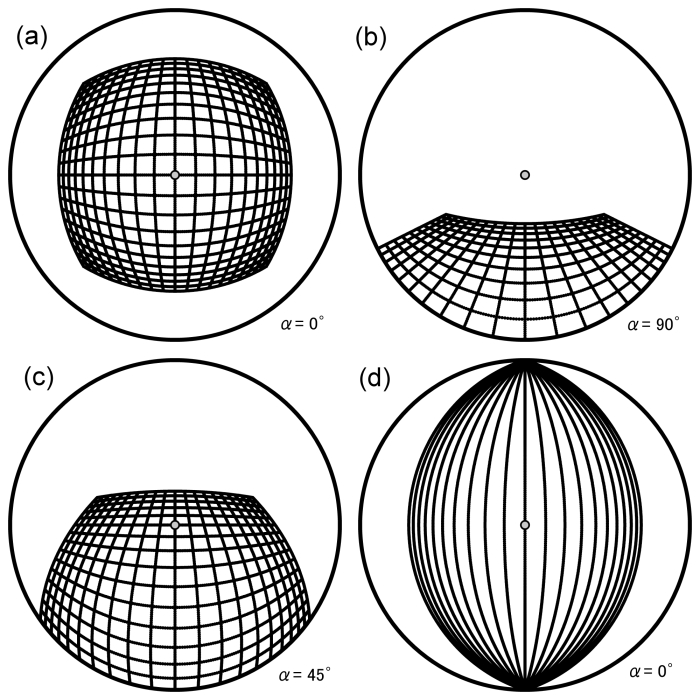
Figure 1. An instance of retinal coordinates. Suppose that twenty by twenty squares (each being 10 cm x 10 cm) are drawn at the center of an infinitely-extended flat plane and observed from 50 cm apart. (a) When the plane is perpendicular to the visual axis, the mesh appears to bulge out though it really has no curves. (b) When the visual axis is parallel to the plane, the lines parallel to the visual axis appear to converge at the center of the visual field while the lines perpendicular to the visual axis (except those that cross the visual axis) appear to curve outward. (c) When the plane is observed obliquely, both (bulging and converging) appearances coexist. (d) Parallel lines on a plane perpendicular to the visual axis meet at two points on the surrounding circle. The gray circle at the center in each panel represents the foveal vision. The radius of the circle is 90 degree of visual angle.
 Given equations
Given equations
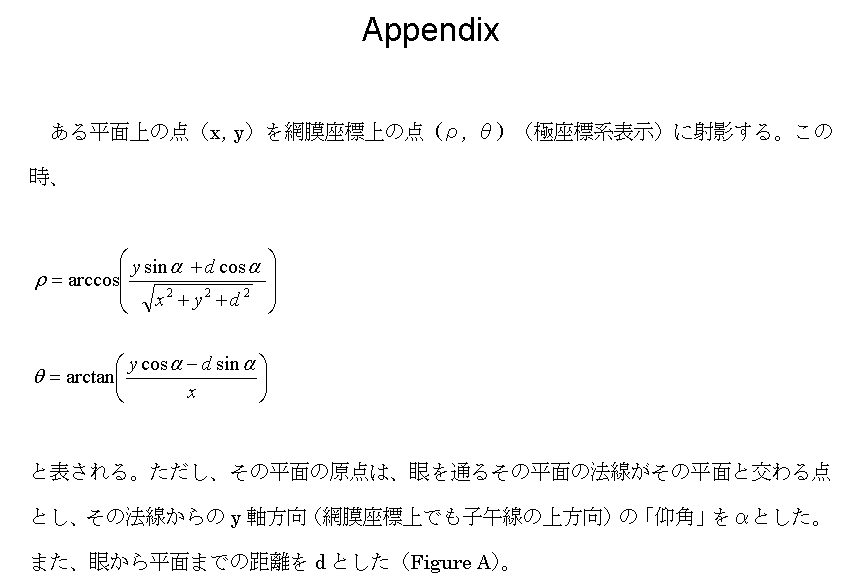
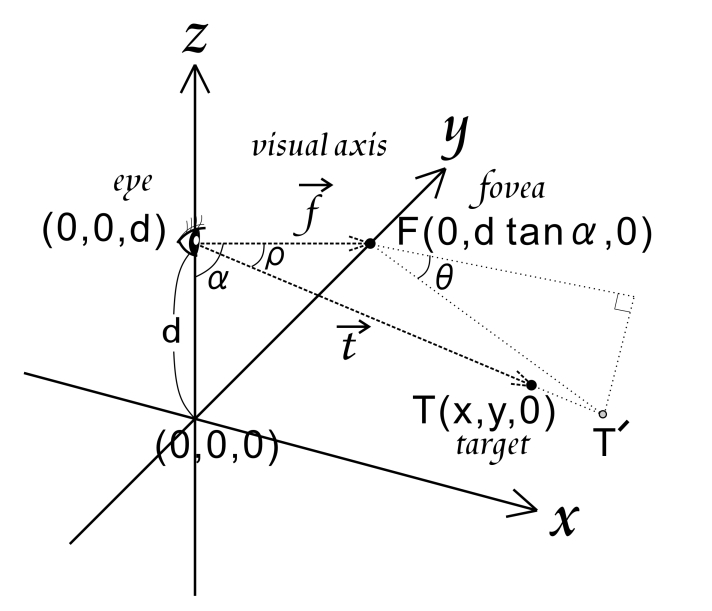
Figure Appendix. The method to obtain the retinal coordinates (ρ,θ) from the visual world. Suppose that the seen object is placed on the x-y plane where a target point T (x, y, 0) is located, and that an observing eye is located on the z-axis with the height of "d". "α" is the angle between the visual axis and the z-axis when the eye sees a point F (foveal point) that is located on the y-axis. The visual angle "ρ" of the target point is the angle between the line from the eye to the foveal point F (vector f) and the line from the eye to the target point T (vector t). The visual angle ρ is obtained from these two vectors. The angle θ is given as the angle between the line parallel to the x-axis through the foveal point F and the line from the foveal point F to another point T´ where the extension of vector t meets the plane that is perpendicular to the visual axis (or vector f) and passes through the foveal point F.
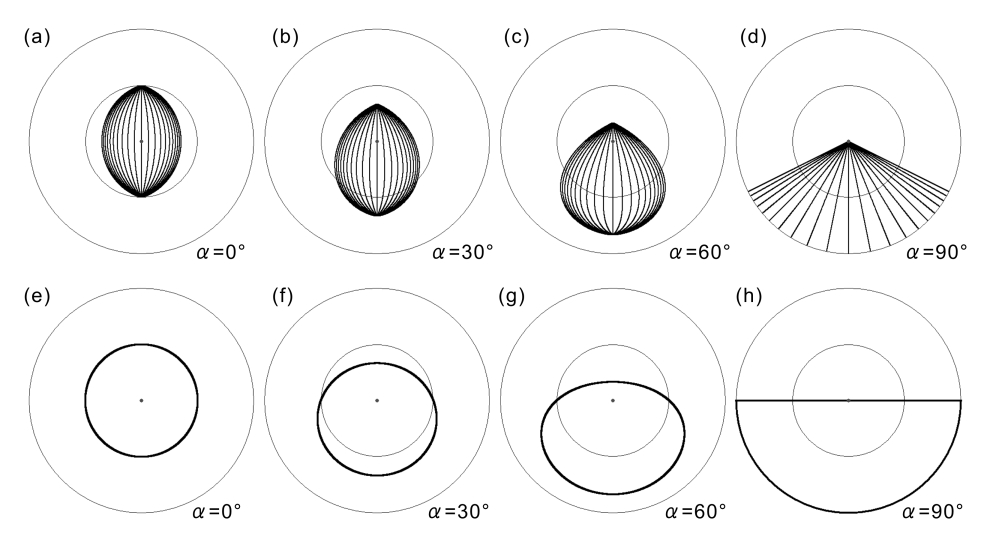
Figure 2. Extended retinal coordinates. The radius of the outer circle represents 180 degrees of “visual angle” while the radius of the inner one shows 90 degrees of visual angle. (a) The image of Figure 1d is placed in these coordinates. (b) and (c) The same image is seen obliquely. (d) The same image is seen in parallel to the plane. (e)-(h) The thick line shows the line at infinity of a plane within which the entire plane is represented.
Line perspective is not an illusion, but mathematics!
 色の錯視
色の錯視 
「肌色錯視」
左のお肌は赤っぽく、右のお肌は黄色っぽく見える。ドット色錯視を適用。
Copyright Akiyoshi Kitaoka 2008 (September 3)
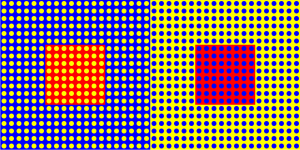
ドット色錯視・・・左右の赤い領域は同じ色であるが、左はオレンジに、右はマゼンタに見える。
ドット色錯視は、ホワイトのドット明るさ錯視の色バージョンである。

ホワイトのドット明るさ錯視・・・灰色の正方形は同じ明るさであるが、左は右よりも明るく見える。
White, M. (1982) The assimilation-enhancing effect of a dotted surround upon a dotted test region. Perception, 11, 103-106.
「四色の犬」
上から1番目と3番目の列の犬は2種類、2番目と4番目の列の犬も2種類いるように見えるが、それぞれ同じ色である。色の土牢錯視である。
Copyright Akiyoshi .Kitaoka 2007 (January 5)
土牢錯視(dungeon illusion)(Bressan, 2001)とは?
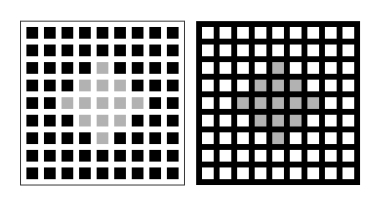
左の「牢屋」の灰色のダイヤモンド形は右のよりも明るく見えるが、物理的には同じ明るさである。
Bressan, P. (2001) Explaining lightness illusions. Perception, 30, 1031-1046.
色の土牢錯視とは?
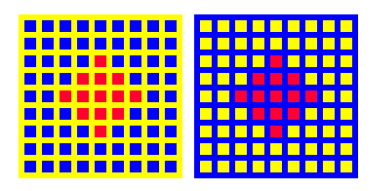
左の「牢屋」のダイヤモンド形はオレンジ色に、右のは少し紫がかった赤に見えるが、物理的には同じ色である。
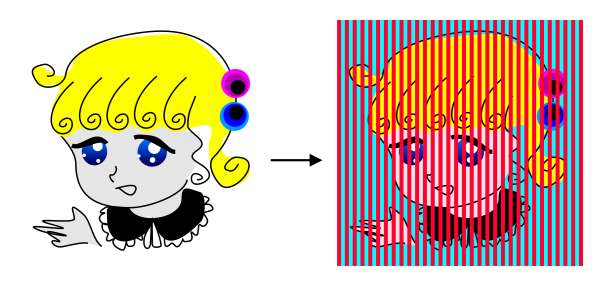
「顔色がよくなる錯視」
顔色がよくなった。
Copyright Akiyoshi .Kitaoka 2007 (March 10)
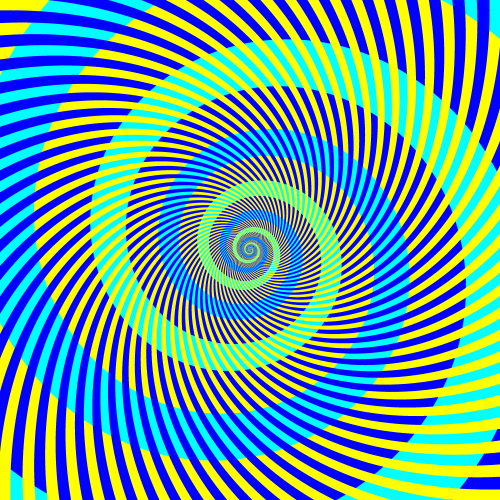
「シアンの渦巻き」
きれいな水色の螺旋と明るい青緑色の螺旋があるように見えるが、どちらも同じシアン(R = 0, G = 255, B = 255)である。
Copyright Akiyoshi .Kitaoka 2008 (July 21)
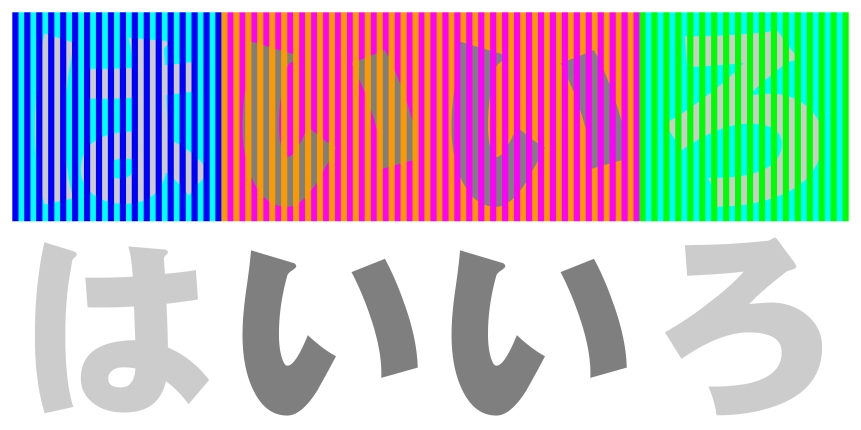
「はいいろ」
灰色の文字が色づいて見える。
Copyright Akiyoshi .Kitaoka 2007 (March 10)
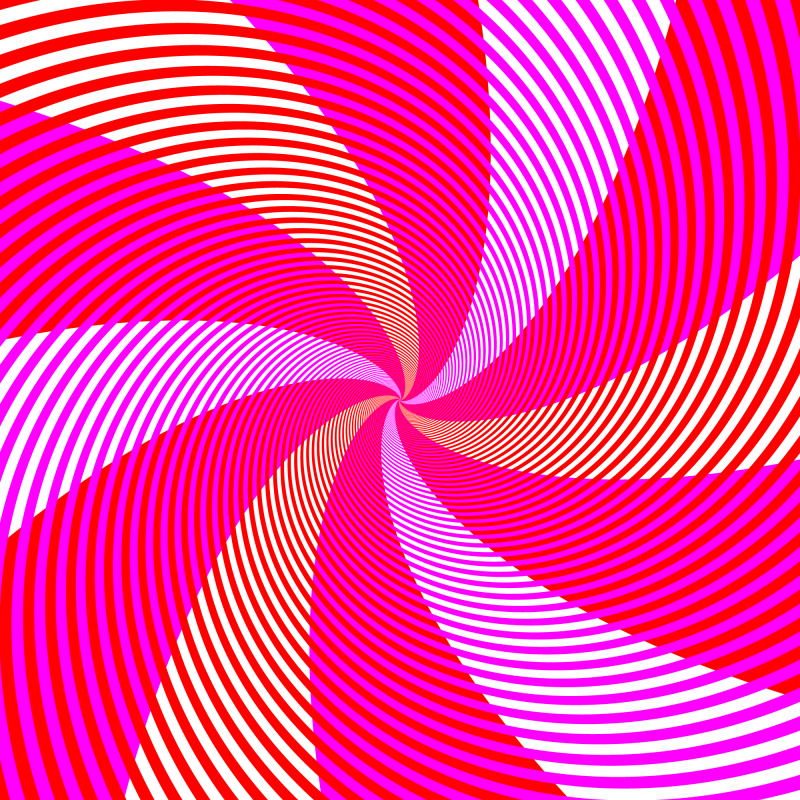
「白と黄色のネクタイ」
白と黄色のネクタイがあるように見えるが、どちらも白(R=255, G=255, B=255)である。
Copyright Akiyoshi .Kitaoka 2007 (March 12)
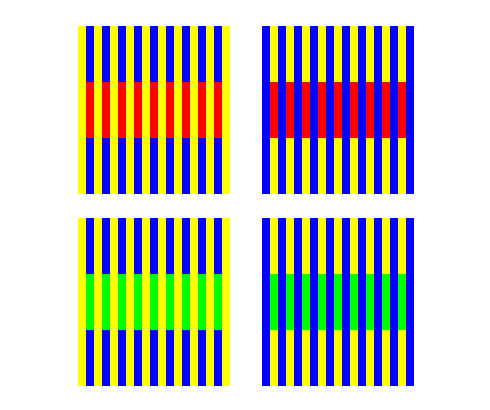
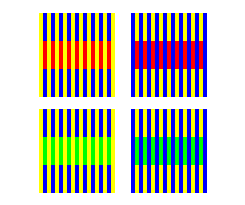
ムンカー錯視
The orange and purple-red shown in the upper row are the same red, and the yellowish-green and bluish green displayed in the lower row are the same green.
Munker, H. (1970) Farbige Gitter, Abbildung auf der Netzhaut und übertragungstheoretische Beschreibung der Farbwahrnehmung. Habilitationsschrift, Ludwig-Maximilians-Universität, München.
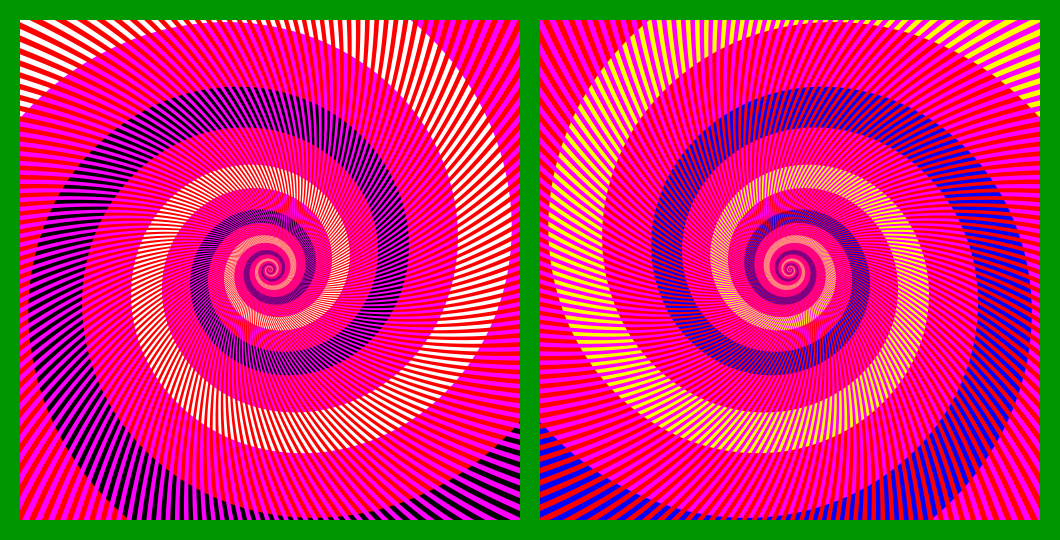
「武田信玄」
薄い黄色と濃い青色の渦巻きがあるように見えるが、左半分は白(R=255, G=255, B=255)と黒(R=0, G=0, B=0)であるのに対し、右半分は黄(R=255, G=255, B=0)と青(R=0, G=0, B=255)である。
Copyright Akiyoshi .Kitaoka 2007 (March 12)
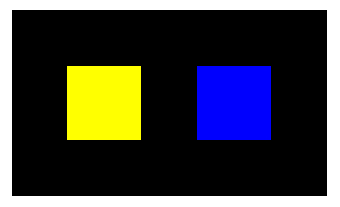
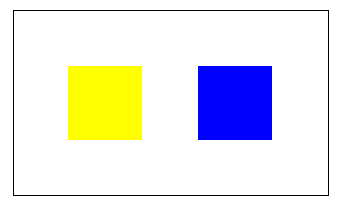
Color sample
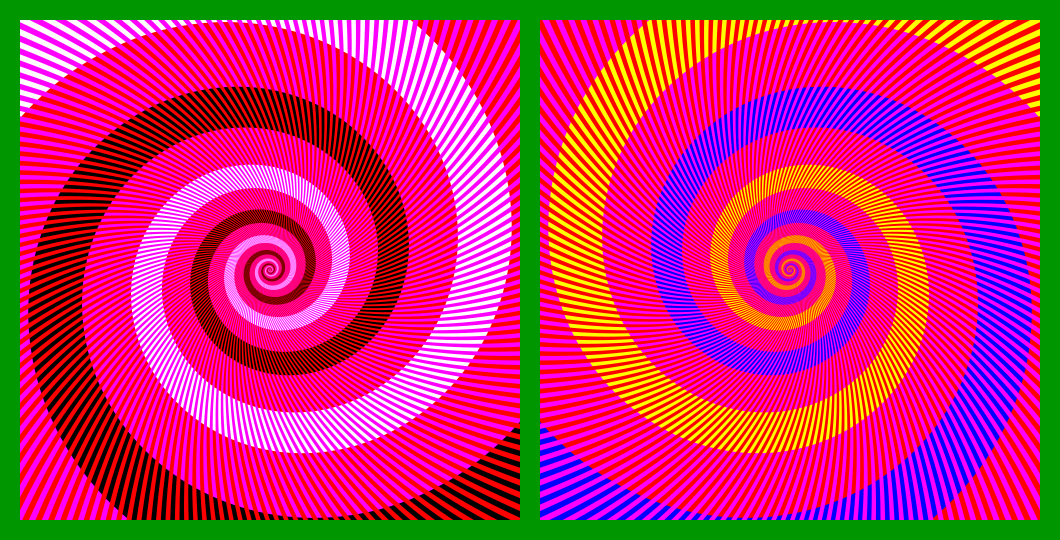
「風林火山」
「武田信玄」の白黒黄青と同じであるが、この図では違いがはっきりわかる。
Copyright Akiyoshi .Kitaoka 2007 (March 12)
 Suggested equations
Suggested equations
Induced color 1 = (+Red) + (-Magenta) = Red + Green = Yellow
Induced color 2 = (-Red) + (+Magenta) = Cyan + Magenta = Blue
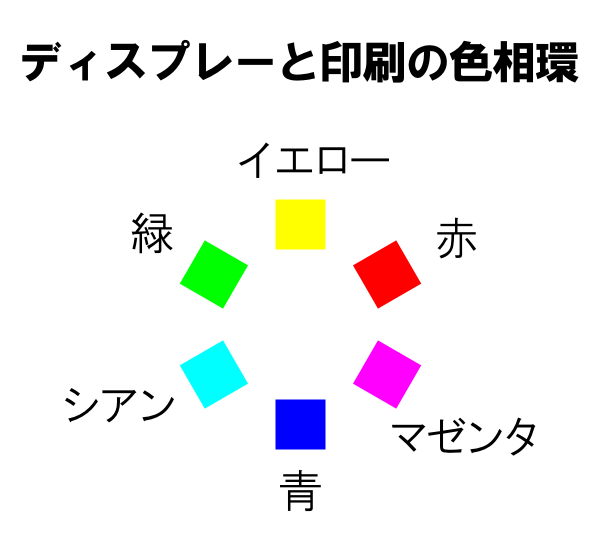



時間が余ったら、他の講演のページ(明るさの錯視やだまし絵など)

まとめ
錯視・数学・美は深い関係がある。
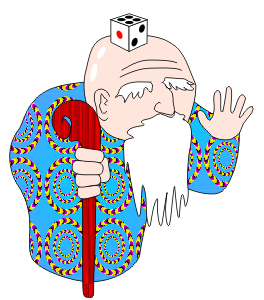 ご清聴ありがとうございました。
ご清聴ありがとうございました。

---